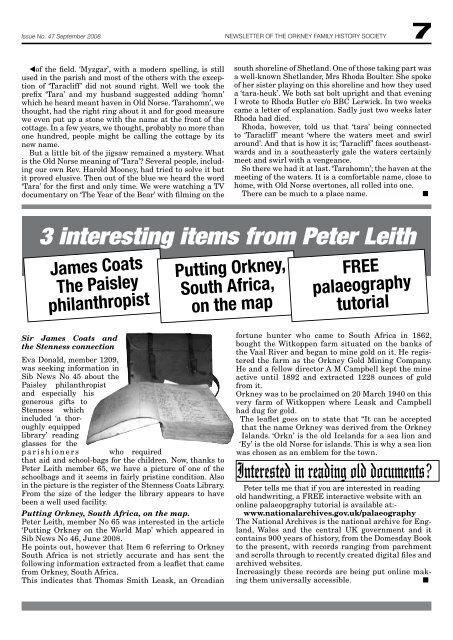SIB FOLK NEWS - Orkney Family History Society
SIB FOLK NEWS - Orkney Family History Society
SIB FOLK NEWS - Orkney Family History Society
Create successful ePaper yourself
Turn your PDF publications into a flip-book with our unique Google optimized e-Paper software.
Issue No. 47 September 2008 <strong>NEWS</strong>LETTER OF THE ORKNEY FAMILY HISTORY SOCIETY 7<br />
Fof the field. ‘Myzgar’, with a modern spelling, is still<br />
used in the parish and most of the others with the exception<br />
of ‘Taracliff’ did not sound right. Well we took the<br />
prefix ‘Tara’ and my husband suggested adding ‘homn’<br />
which he heard meant haven in Old Norse. ‘Tarahomn’, we<br />
thought, had the right ring about it and for good measure<br />
we even put up a stone with the name at the front of the<br />
cottage. In a few years, we thought, probably no more than<br />
one hundred, people might be calling the cottage by its<br />
new name.<br />
But a little bit of the jigsaw remained a mystery. What<br />
is the Old Norse meaning of ‘Tara’? Several people, including<br />
our own Rev. Harold Mooney, had tried to solve it but<br />
it proved elusive. Then out of the blue we heard the word<br />
‘Tara’ for the first and only time. We were watching a TV<br />
documentary on ‘The Year of the Bear’ with filming on the<br />
south shoreline of Shetland. One of those taking part was<br />
a well-known Shetlander, Mrs Rhoda Boulter. She spoke<br />
of her sister playing on this shoreline and how they used<br />
a ‘tara-heuk’. We both sat bolt upright and that evening<br />
I wrote to Rhoda Butler c/o BBC Lerwick. In two weeks<br />
came a letter of explanation. Sadly just two weeks later<br />
Rhoda had died.<br />
Rhoda, however, told us that ‘tara’ being connected<br />
to ‘Taracliff’ meant ‘where the waters meet and swirl<br />
around’. And that is how it is; ‘Taracliff’ faces southeastwards<br />
and in a southeasterly gale the waters certainly<br />
meet and swirl with a vengeance.<br />
So there we had it at last. ‘Tarahomn’; the haven at the<br />
meeting of the waters. It is a comfortable name, close to<br />
home, with Old Norse overtones, all rolled into one.<br />
There can be much to a place name. L<br />
3 interesting items from Peter Leith<br />
James Coats<br />
The Paisley<br />
philanthropist<br />
Sir James Coats and<br />
the Stenness connection<br />
Eva Donald, member 1209,<br />
was seeking information in<br />
Sib News No 45 about the<br />
Paisley philanthropist<br />
and especially his<br />
generous gifts to<br />
Stenness which<br />
included ‘a thoroughly<br />
equipped<br />
library’ reading<br />
glasses for the<br />
p a r i s h i o n e r s who required<br />
that aid and school-bags for the children. Now, thanks to<br />
Peter Leith member 65, we have a picture of one of the<br />
schoolbags and it seems in fairly pristine condition. Also<br />
in the picture is the register of the Stenness Coats Library.<br />
From the size of the ledger the library appears to have<br />
been a well used facility.<br />
Putting <strong>Orkney</strong>, South Africa, on the map.<br />
Peter Leith, member No 65 was interested in the article<br />
‘Putting <strong>Orkney</strong> on the World Map’ which appeared in<br />
Sib News No 46, June 2008.<br />
He points out, however that Item 6 referring to <strong>Orkney</strong><br />
South Africa is not strictly accurate and has sent the<br />
following information extracted from a leaflet that came<br />
from <strong>Orkney</strong>, South Africa.<br />
This indicates that Thomas Smith Leask, an Orcadian<br />
Putting <strong>Orkney</strong>,<br />
South Africa,<br />
on the map<br />
FREE<br />
palaeography<br />
tutorial<br />
fortune hunter who came to South Africa in 1862,<br />
bought the Witkoppen farm situated on the banks of<br />
the Vaal River and began to mine gold on it. He registered<br />
the farm as the <strong>Orkney</strong> Gold Mining Company.<br />
He and a fellow director A M Campbell kept the mine<br />
active until 1892 and extracted 1228 ounces of gold<br />
from it.<br />
<strong>Orkney</strong> was to be proclaimed on 20 March 1940 on this<br />
very farm of Witkoppen where Leask and Campbell<br />
had dug for gold.<br />
The leaflet goes on to state that “It can be accepted<br />
that the name <strong>Orkney</strong> was derived from the <strong>Orkney</strong><br />
Islands. ‘Orkn’ is the old Icelands for a sea lion and<br />
‘Ey’ is the old Norse for islands. This is why a sea lion<br />
was chosen as an emblem for the town.<br />
Interested in reading old documents?<br />
Peter tells me that if you are interested in reading<br />
old handwriting, a FREE interactive website with an<br />
online palaeopgraphy tutorial is available at:www.nationalarchives.gov.uk/palaeography<br />
The National Archives is the national archive for England,<br />
Wales and the central UK government and it<br />
contains 900 years of history, from the Domesday Book<br />
to the present, with records ranging from parchment<br />
and scrolls through to recently created digital files and<br />
archived websites.<br />
Increasingly these records are being put online making<br />
them universally accessible. L



